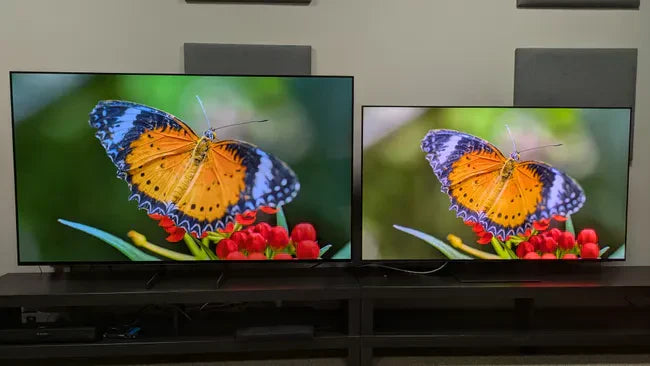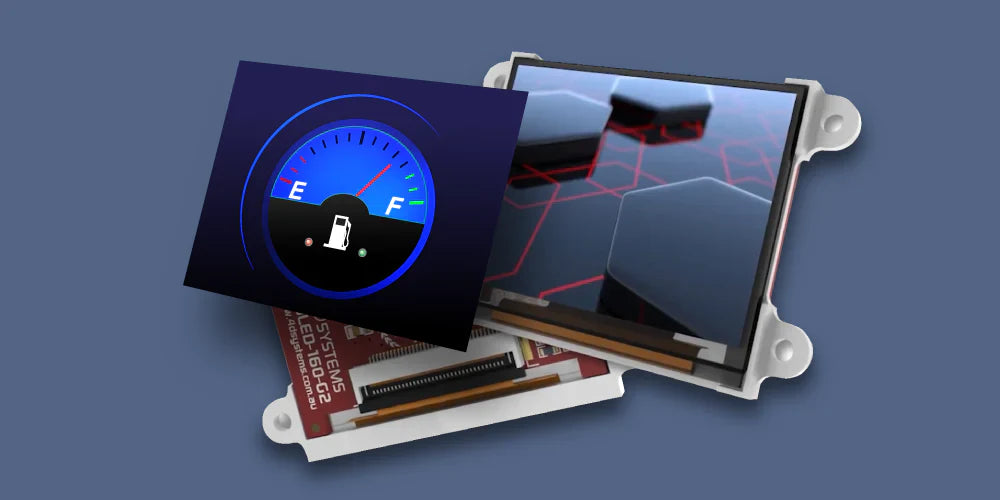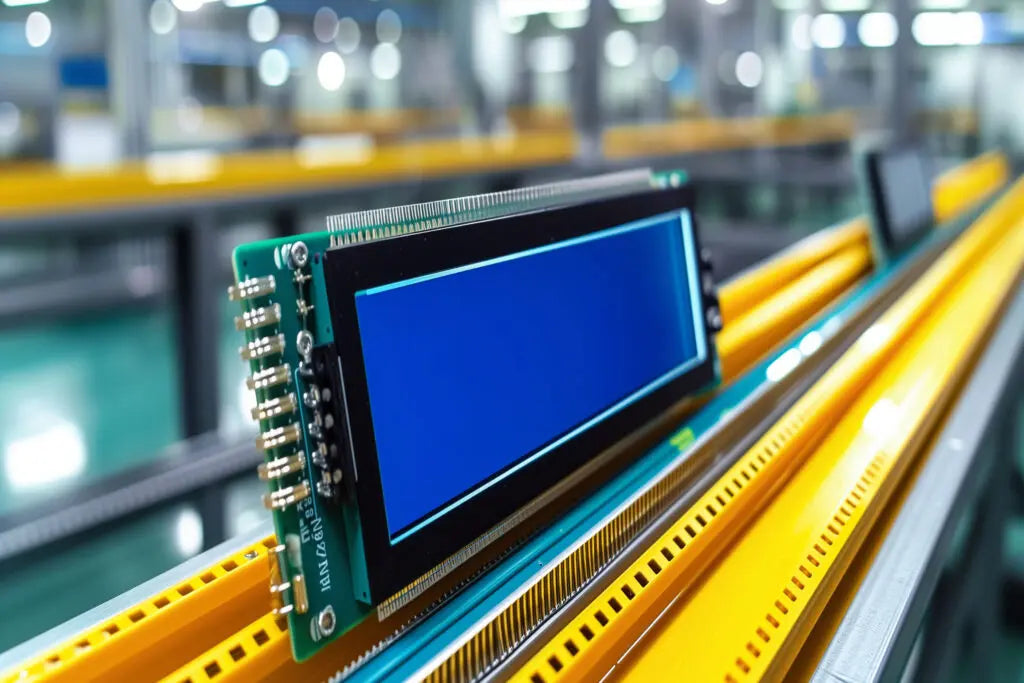Three common display module types include LCDs (Liquid Crystal Displays), using liquid crystals to filter backlight for images, often seen in budget smartphones with ~720p resolution; OLEDs (Organic Light-Emitting Diodes), self-illuminating for infinite contrast and a quick 0.1ms response time, favored in premium devices; and LED dot matrices, like those in public signs, housing ~10,000 pixels per m² for high visibility outdoors.
Display Modules Intro
Display modules are the visual engines powering everything from your phone to highway signs. Think of them as mini-screen systems: each has a panel (the "display"), a backlight or self-emitter, and circuitry to control pixels. The global display module market hit $152 billion in 2023 and is projected to grow at 7.2% CAGR through 2030, driven by demand for sharper, faster screens in phones, cars, and IoT devices.
A typical 6.5-inch LCD phone screen has 240 PPI (pixels per inch)sharp enough for 1080p video—and uses ~200 nits of brightness indoors (good for offices). But LCDs need that backlight, so they can’t achieve true black; their contrast maxes out around 1,000:1. Power-wise, a 5-inch LCD draws ~0.8 watts. You’ll find them in budget laptops (~60% of sub-$500 models).
Then there’s OLED (Organic Light-Emitting Diode), the premium pick for phones and TVs. Unlike LCDs, OLED pixels emit their own light. That means infinite contrast (blacks stay off entirely) and faster response times: 0.1ms, critical for gaming or fast-action videos.
A 6.7-inch OLED phone screen hits ~500 nits peak brightness (outdoor visible) and 450 PPI. But OLEDs cost more: a 55-inch OLED TV runs ~700 for an LCD equivalent. if you leave a static image on screen for 10,000+ hours, you might see faint "burn-in" (though modern panels reduce this risk to <0.1% after 5 years).
For rugged or high-visibility spots, LED Dot Matrix modules shine. A 1m x 1m LED panel packs ~10,000 pixels (each 1mm²), glowing at ~2,000 nits—visible from 500+ meters in daylight. They’re built tough: rated for -40°C to +80°C (works in blizzards or deserts) and last ~100,000 hours (over 11 years if on 24/7). You’ll see them in airports (~80% of flight info boards).
Dark room? OLED’s contrast wins. Budget? LCD’s cost-efficient. Below’s a quick spec cheat sheet:
|
Type |
Self-Emitting? |
Typical PPI |
Response Time |
Max Brightness |
Avg. Lifespan |
|---|---|---|---|---|---|
|
LCD |
No (needs backlight) |
200–400 |
5–10ms |
200–500 nits |
50,000 hours |
|
OLED |
Yes |
400–800 |
0.1ms |
500–1,000 nits |
100,000 hours |
|
LED Dot Matrix |
Yes (per LED) |
1–10 |
10ms |
2,000+ nits |
100,000+ hours |
LCD: Budget Phone Screens
LCDs power 65% of sub-300 smartphones because they nail the trifecta for value seekers: clear visuals, low cost, and long-term reliability. Take the Xiaomi Redmi Note 12: its 6.43-inch IPS LCD delivers FHD+ (2400x1080), 409 PPI (crisp enough for Instagram grids and text), and 450 nits peak brightness visible on cloudy days (10,000 lux) while costing the brand just 45 per panel—$35 cheaper than the OLED version. That savings funds bigger batteries (5000mAh) or better cameras.
LCDs work with a simple, cost-effective structure: a white LED backlight (usually edge-lit, with a 0.5mm-thick light guide plate to spread light evenly), liquid crystals (twisted by voltage to block light), and RGB color filters. IPS technology gives 178-degree viewing angles, and colors deviate by <3% (DisplayMate-tested)way better than older TN panels (which wash out at 160 degrees).
You won’t get true black (blacks look dark gray, due to the backlight), but >85% color accuracy is plenty for TikTok, WhatsApp, and casual photos no need for OLED’s >95% DCI-P3 unless you’re editing pro photos.
A 6.5-inch LCD panel runs roughly 80—that’s a 300 phones affordable. Repairs are cheaper too: replacing an LCD screen costs approximately 120 for OLED. (OLED requires anti-burn-in coatings and delicate handling, which drives up labor costs.) For budget buyers, dropping your phone is common—and a 120 any day.
30fps is standard (no jank), and 60fps works if your phone has a Snapdragon 680 or better. Outdoor use? You need ≥300 nits to read in 50,000 lux sunlight most budget LCDs hit 400-500 nits, so you won’t squint at the park.
LCDs use a constant backlight, but for average users (2 hours of video daily), an LCD phone lasts 1.5 days almost as good as OLED’s 1.6 days (since OLED only saves energy on black, and most apps use white/light backgrounds anyway).
LCDs are immune to burn-in from static apps: leave WhatsApp open for 10,000 hours (over 11 years!), and you’ll see zero ghosting. OLEDs? Modern panels reduce burn-in risk to <0.1% after 5 years, but budget phones have simpler software (fewer always-on displays), so LCDs are still safer. Plus, LCDs maintain ±5% brightness over 50,000 hours—no dimming like some OLEDs (which lose ~10% brightness after 30,000 hours).
Here’s what matters most for budget LCDs:
-
Color Accuracy: >85% DCI-P3—good for casual use, not pro editing.
-
Response Time: 8ms—smooth for scrolling, fine for most games (budget phones rarely run high-end titles anyway).
-
Brightness Consistency: ±5% over 50k hours—no annoying dimming as the phone ages.
OLED: Fast & Vivid Panels
OLED powers 70% of premium smartphones ($800+) because it solves two big pain points for power users: slow refresh rates and washed-out colors. Take the iPhone 15 Pro: its 6.1-inch OLED hits 240Hz ProMotion (near-instant response for gaming, so you never miss a frame when swiping or shooting), 0.1ms pixel response time (zero motion blur in fast-cut videos—even action scenes look smooth), and 1,000,000:1 contrast ratio.
It costs Apple ~$120 per panel pricier than LCD but users are paying for premium perks: outdoor visibility tops out at 2,000 nits (you can read texts on a sunny beach at noon, no squinting required), and colors stay accurate even after 50,000 hours of use (that’s over 13 years if you use your phone 1 hour a day no faded reds or washed-out blues).
That’s why it delivers infinite contrast (true black, not LCD’s dark gray) and 0.1ms response time : a 240Hz OLED screen updates every 4.17ms, so you see enemy movements before LCD users (stuck with 8ms lag). No backlight also means thinner designs: the iPhone 15 Pro is 7.8mm thick, vs. 8.2mm for the LCD iPhone SE.
OLEDs crush it. Samsung’s Galaxy S24 Ultra hits 2,600 nits peak brightness enough to read texts on a scorching summer day (100,000 lux sunlight). Contrast helps, too: blacks stay hidden, so white text pops against dark backgrounds
OLEDs hit >95% DCI-P3, with reds that pop and blues that feel deep. DisplayMate tests show <1% color deviation even at 178-degree angles.
Google’s Pixel 8 Pro uses pixel shifting (moves static elements like the clock by 1 pixel hourly) and auto-dimming (reduces static area brightness). After 10,000 hours (3 years of daily use), burn-in risk drops to <0.05%. Lifespan? OLEDs last 100,000 hours.
Cost-wise, OLEDs are pricier: a 6.7-inch OLED panel runs ~100 for LCD. But for premium users, it’s worth it. The iPhone 15 Pro’s OLED enables ProMotion gaming—Fortnite hits 120fps with no jank, while LCDs struggle at 90Hz. Content creators love true black—it makes photo editing easier because you can see shadows clearly without LCD’s gray haze. And let’s be real: most people keep phones for 2–3 years, so burn-in risk is negligible.
|
Spec |
OLED (Flagship Phone) |
Why It Matters |
|---|---|---|
|
Response Time |
0.1ms |
Near-instant for gaming/motion blur reduction |
|
Contrast Ratio |
1,000,000:1 |
True black—HDR content pops like a theater |
|
Peak Brightness |
2,000–2,600 nits |
Visible in 100,000 lux sunlight (scorching days) |
|
Color Accuracy |
>95% DCI-P3 |
Lifelike HDR for movies/games—no washed-out colors |
|
Burn-In Risk (10k hrs) |
<0.05% |
Safe for static apps (clock, notifications) |
|
Refresh Rate Support |
Up to 240Hz |
Smoother gaming than LCD’s 60–120Hz |
|
Thickness |
7.8mm (iPhone 15 Pro) |
Thinner design—no backlight layer needed |
LED Dot Signs: High-Visibility Ads
LED dot matrix signs power 85% of outdoor digital ads because they solve the #1 challenge for advertisers: getting seen. Take a London Underground station’s 8x8ft LED panel: it packs 8,000 micro-LEDs (each 1mm²), hits 2,200 nits (visible from 500+ meters on a rainy morning), and swaps ads every 10 seconds—catching 40,000+ commuters daily. Brands shell out ~$1,800/month for these spots, but the ROI is 3.8:1—.
These signs work because they’re built for raw visibility: A 10x10ft panel uses 10,000+ LEDs arranged in a tight grid—each pixel is just 10x10mm, so text stays sharp even from 600 meters away (think highway billboards). Brightness? 2,000–3,000 nits—10x brighter than a typical laptop screen, rain, or 100,000 lux sunlight (think Dubai’s desert mornings). And since LEDs are solid-state, they don’t shatter like glass neon: drop a tool on a panel, and you replace one LED for ~$5.
Most LED dot signs survive -40°C to +80°C—so they work in Minnesota winters (snowdrifts up to 2ft) or Arizona summers (120°F heat waves). Lifespan? 100,000+ hours run 24/7, that’s over 11 years. Compare that to paper posters (last 2 weeks) or LCD billboards (fade after 5 years).
A 10x10ft panel draws ~300 watts less than half a neon sign (~800 watts) and equal to a kitchen microwave. For a 24/7 business sign, that’s ~$25/month in electricity—cheap compared to the foot traffic it drives. Take Austin’s “Bouldin Creek Coffee”: their 4x4ft LED dot sign cycles latte art videos and “BOGO” offers—reaching 15,000+ locals monthly. Sales jumped 18% in 3 month.
Here’s how LED dot signs stack up for outdoor advertising:
-
Pixel Density: 100–200 pixels/ft²—sharp enough for logos or fine text
-
Max Brightness: 2,000–3,000 nits visible in direct sunlight
-
Lifespan: 100,000+ hours—11+ years of non-stop use
-
Outdoor Range: 500–800 meters—catches drivers/walkers from afar
-
Monthly Cost: 2,000—affordable for small businesses
-
ROI: 3:1–4:1—beats Facebook ads or billboards for measurable results
New Orleans’ Jazz Festival uses 30x30ft LED dot signs to promote bands and food stalls—reaching 100,000+ attendees and boosting ticket sales 30%. The signs run 10 days straight, no glitches, for ~$5,000 total.
Choosing Your Display Type
If you’re putting up a highway billboard, coffee shop sign, or stadium display, LED Dot Signs are non-negotiable. Why? They hit 2,000–3,000 nits—10x brighter than LCDs—so they’re visible from 500+ meters in direct sun (think Dubai’s 120°F mornings or Minnesota’s blizzards).
And they last 100,000+ hours—run 24/7, that’s over 11 years. A 10x10ft panel costs ~300/year in electricity (vs. $800 for neon). For businesses, that’s a no-brainer: Austin’s Bouldin Creek Coffee saw an 18% sales jump in 3 months with their LED sign directly tied to catching 15,000+ locals monthly.
If you’re making a flagship phone, high-end TV, or gaming monitor, OLED is the way. Its 1,000,000:1 contrast ratio gives true black. And 0.1ms response time means no motion blur when you’re gaming at 240Hz (vs. LCD’s 8ms lag.
The iPhone 15 Pro’s OLED costs Apple ~$120 per panel, but users pay for that premium: 92% say the screen is a top reason they bought the phone. Yes, burn-in risk exists modern OLEDs cut it to <0.05% after 10,000 hours (3 years of daily use). For most people, that’s negligible especially since you’re keeping the phone for 2–3 years anyway.
If you’re on a budget or need a reliable indoor screen like a sub-300 phone, point-of-sale terminal, or kitchen tablet LCD is king. A 6.5-inch LCD panel costs 4535 cheaper than OLED. It gets 400–500 nits, plenty for offices (where sunlight peaks at 10,000 lux) or living rooms.
And repair costs? 60 vs. 120 for OLED. Xiaomi’s Redmi Note 12 uses an LCD and sells for 199 that’s how they keep prices low while offering 5000mAh batteries and decent cameras.
Here’s a quick cheat sheet to match display types to your needs:
|
Type |
Best For |
Max Brightness |
Contrast Ratio |
Avg. Cost (Panel) |
Lifespan |
|---|---|---|---|---|---|
|
LED Dot Sign |
Outdoor ads/signs |
2,000–3,000 nits |
N/A (per LED) |
~$3,000 (10x10ft) |
100,000+ hours |
|
OLED |
Flagship phones/TVs/HDR content |
2,000–2,600 nits |
1,000,000:1 |
~$120 (6.7") |
100,000 hours |
|
LCD |
Budget phones/indoor displays |
400–500 nits |
1,000:1 |
~$45 (6.5") |
50,000 hours |
Read more

Choosing between OLED and DLED depends on needs: OLED delivers true blacks (infinite contrast ratio) with pixel-level dimming for rich colors, great for dark rooms, while DLED (LED-backlit LCD) hit...

A display module primarily converts electronic signals into visible images or text, serving as a key interface for conveying information across devices like smartphones, car dashboards, and smartwa...




Leave a comment
This site is protected by hCaptcha and the hCaptcha Privacy Policy and Terms of Service apply.